Abstract
Both rs17782313 (near MC4R) and rs1421085 (FTO) polymorphisms have been consistently associated with increased risk of obesity and with body mass index (BMI) variation. An effect of both polymorphisms on satiety has recently been suggested. We genotyped rs17782313 and rs1421085 in 5764 relatives from 1109 French pedigrees with familial obesity, 1274 Swiss class III obese adults as well as in 4877 French adults and 5612 Finnish teenagers from two randomly selected population cohorts. In all subjects, eating behaviour traits were documented through questionnaires. We first assessed the association of both single nucleotide polymorphisms with BMI and then studied eating behaviour. Under an additive model, the rs17782313-C MC4R allele showed a trend towards higher percentages of snacking in both French obese children (P=0.01) and Swiss obese adults (P=0.04) as well as in adolescents from the Finnish general population (P=0.04). In French adults with familial obesity, this allele tended to be also associated with a higher Stunkard hunger score (P=0.02) and in obese children with a higher prevalence of eating large amounts of food (P=0.04). However, no consistent association of the FTO rs1421085-C allele and available eating behaviour trait was found in our studied populations. The rs17782313-C allele nearby MC4R may modulate eating behaviour-related phenotypes in European obese and randomly selected populations, in both children and adults, supporting a regulatory role of this genetic variant on eating behaviour, as previously shown for MC4R non-synonymous loss-of-function mutations. The potential effect of the obesity-associated FTO gene on eating behaviour deserves additional investigation.
This is a preview of subscription content, access via your institution
Access options
Subscribe to this journal
Receive 12 print issues and online access
$259.00 per year
only $21.58 per issue
Buy this article
- Purchase on Springer Link
- Instant access to full article PDF
Prices may be subject to local taxes which are calculated during checkout
Similar content being viewed by others
References
Dina C, Meyre D, Gallina S, Durand E, Korner A, Jacobson P et al. Variation in FTO contributes to childhood obesity and severe adult obesity. Nat Genet 2007; 39: 724–726.
Frayling TM, Timpson NJ, Weedon MN, Zeggini E, Freathy RM, Lindgren CM et al. A common variant in the FTO gene is associated with body mass index and predisposes to childhood and adult obesity. Science 2007; 316: 889–894.
Hinney A, Nguyen TT, Scherag A, Friedel S, Bronner G, Muller TD et al. Genome wide association (GWA) study for early onset extreme obesity supports the role of fat mass and obesity associated gene (FTO) variants. PLoS ONE 2007; 2: e1361.
Scuteri A, Sanna S, Chen WM, Uda M, Albai G, Strait J et al. Genome-wide association scan shows genetic variants in the FTO gene are associated with obesity-related traits. PLoS Genet 2007; 3: e115.
Fredriksson R, Hagglund M, Olszewski PK, Stephansson O, Jacobsson JA, Olszewska AM et al. The obesity gene, FTO, is of ancient origin, upregulated during food deprivation and expressed in neurons of feeding-related nuclei of the brain. Endocrinology 2008; 149: 2062–2071.
Gerken T, Girard CA, Tung YC, Webby CJ, Saudek V, Hewitson KS et al. The obesity-associated FTO gene encodes a 2-oxoglutarate-dependent nucleic acid demethylase. Science 2007; 318: 1469–1472.
Do R, Bailey SD, Desbiens K, Belisle A, Montpetit A, Bouchard C et al. Genetic variants of FTO influence adiposity, insulin sensitivity, leptin levels, and resting metabolic rate in the Quebec Family Study. Diabetes 2008; 57: 1147–1150.
Speakman JR, Rance KA, Johnstone AM . Polymorphisms of the FTO gene are associated with variation in energy intake, but not energy expenditure. Obesity (Silver Spring) 2008; 16: 1961–1965.
Wardle J, Carnell S, Haworth CM, Farooqi IS, O’Rahilly S, Plomin R . Obesity-associated genetic variation in FTO is associated with diminished satiety. J Clin Endocrinol Metab 2008; 93: 3640–3643.
Loos RJ, Lindgren CM, Li S, Wheeler E, Zhao JH, Prokopenko I et al. Common variants near MC4R are associated with fat mass, weight and risk of obesity. Nat Genet 2008; 40: 768–775.
Chambers JC, Elliott P, Zabaneh D, Zhang W, Li Y, Froguel P et al. Common genetic variation near MC4R is associated with waist circumference and insulin resistance. Nat Genet 2008; 40: 716–718.
Gantz I, Miwa H, Konda Y, Shimoto Y, Tashiro T, Watson SJ et al. Molecular cloning, expression, and gene localization of a fourth melanocortin receptor. J Biol Chem 1993; 268: 15174–15179.
Farooqi IS, Keogh JM, Yeo GS, Lank EJ, Cheetham T, O’Rahilly S . Clinical spectrum of obesity and mutations in the melanocortin 4 receptor gene. N Engl J Med 2003; 348: 1085–1095.
Qi L, Kraft P, Hunter DJ, Hu FB . The common obesity variant near MC4R gene is associated with higher intakes of total energy and dietary fat, weight change, and diabetes risk in women. Hum Mol Genet 2008; 17: 3502–3508.
Rolland-Cachera MF, Cole TJ, Sempe M, Tichet J, Rossignol C, Charraud A . Body mass index variations: centiles from birth to 87 years. Eur J Clin Nutr 1991; 45: 13–21.
Poskitt EM . Defining childhood obesity: the relative body mass index (BMI). European Childhood Obesity group. Acta Paediatr 1995; 84: 961–963.
Stunkard AJ, Messick S . The three-factor eating questionnaire to measure dietary restraint, disinhibition and hunger. J Psychosom Res 1985; 29: 71–83.
Durand E, Boutin P, Meyre D, Charles MA, Clement K, Dina C et al. Polymorphisms in the amino acid transporter solute carrier family 6 (neurotransmitter transporter) member 14 gene contribute to polygenic obesity in French Caucasians. Diabetes 2004; 53: 2483–2486.
Branson R, Potoczna N, Kral JG, Lentes KU, Hoehe MR, Horber FF . Binge eating as a major phenotype of melanocortin 4 receptor gene mutations. N Engl J Med 2003; 348: 1096–1103.
Spitzer RL, Yanovski S, Wadden T, Wing R, Marcus MD, Stunkard A et al. Binge eating disorder: its further validation in a multisite study. Int J Eat Disord 1993; 13: 137–153.
Balkau B . An epidemiologic survey from a network of French Health Examination Centres, (D.E.S.I.R.): epidemiologic data on the insulin resistance syndrome. Rev Epidemiol Sante Publique 1996; 44: 373–375.
Meyre D, Bouatia-Naji N, Vatin V, Veslot J, Samson C, Tichet J et al. ENPP1 K121Q polymorphism and obesity, hyperglycaemia and type 2 diabetes in the prospective DESIR Study. Diabetologia 2007; 50: 2090–2096.
Balkau B, Eschwege E, Tichet J, Marre M . Proposed criteria for the diagnosis of diabetes: evidence from a French epidemiological study (D.E.S.I.R.). Diabetes Metab 1997; 23: 428–434.
O’Connell JR, Weeks DE . PedCheck: a program for identification of genotype incompatibilities in linkage analysis. Am J Hum Genet 1998; 63: 259–266.
Spielman RS, Ewens WJ . A sibship test for linkage in the presence of association: the sib transmission/disequilibrium test. Am J Hum Genet 1998; 62: 450–458.
Zhang S, Zhang K, Li J, Sun F, Zhao H . Test of association for quantitative traits in general pedigrees: the quantitative pedigree disequilibrium test. Genet Epidemiol 2001; 21 (Suppl 1): S370–S375.
Hardin JW, Hilbe JM . Generalized Estimating Equations. http://www.stata.com/help.cgi?xtgee (Chapman & Hall/CRC, 2003).
R-Development-Core-Team. R: A Language and Environment for Statistical Computing. R Foundation for Statistical Computing, Vienna, Austria, http://www.R-project.org 2007.
Cauchi S, Stutzmann F, Proença C, Durand E, Meyre D, Pouta A et al. Combined effects of MC4R and FTO genetic variants on obesity in European general populations. Plos Genetics 2008. Submitted.
Farooqi S, O’Rahilly S . Genetics of obesity in humans. Endocr Rev 2006; 27: 710–718.
Jakes RW, Day NE, Luben R, Welch A, Bingham S, Mitchell J et al. Adjusting for energy intake—what measure to use in nutritional epidemiological studies? Int J Epidemiol 2004; 33: 1382–1386.
Heid IM, Vollmert C, Hinney A, Doring A, Geller F, Lowel H et al. Association of the 103I MC4R allele with decreased body mass in 7937 participants of two population based surveys. J Med Genet 2005; 42: e21.
Stutzmann F, Vatin V, Cauchi S, Morandi A, Jouret B, Landt O et al. Non-synonymous polymorphisms in melanocortin-4 receptor protect against obesity: the two facets of a Janus obesity gene. Hum Mol Genet 2007; 16: 1837–1844.
Andreasen CH, Stender-Petersen KL, Mogensen MS, Torekov SS, Wegner L, Andersen G et al. Low physical activity accentuates the effect of the FTO rs9939609 polymorphism on body fat accumulation. Diabetes 2008; 57: 95–101.
Berentzen T, Kring SI, Holst C, Zimmermann E, Jess T, Hansen T et al. Lack of association of fatness-related FTO gene variants with energy expenditure or physical activity. J Clin Endocrinol Metab 2008; 93: 2904–2908.
Acknowledgements
We thank the patients and families who participated in this study. This work was supported in part by Conseil Regional Nord-Pas de Calais and ‘Association Française des Diabétiques’ funding. The NFBC study was conducted with the support of the Academy of Finland and the European Commission (Framework 5 award QLG1-CT-2000-01643). We thank Professor Leena Peltonen-Palotie for her contribution in DNA extraction and distribution.
Author information
Authors and Affiliations
Corresponding author
Additional information
Competing interest statement
The authors declare that they have no competing financial interests.
Rights and permissions
About this article
Cite this article
Stutzmann, F., Cauchi, S., Durand, E. et al. Common genetic variation near MC4R is associated with eating behaviour patterns in European populations. Int J Obes 33, 373–378 (2009). https://doi.org/10.1038/ijo.2008.279
Received:
Revised:
Accepted:
Published:
Issue Date:
DOI: https://doi.org/10.1038/ijo.2008.279
Keywords
This article is cited by
-
Interaction of MC4R rs17782313 variants and dietary carbohydrate quantity and quality on basal metabolic rate and general and central obesity in overweight/obese women: a cross-sectional study
BMC Endocrine Disorders (2022)
-
Association and interaction of the MC4R rs17782313 polymorphism with plasma ghrelin, GLP-1, cortisol, food intake and eating behaviors in overweight/obese Iranian adults
BMC Endocrine Disorders (2022)
-
Nutrigenetic variants and response to diet/lifestyle intervention in obese subjects: a pilot study
Acta Diabetologica (2022)
-
Independent and combined associations between fast-food outlet exposure and genetic risk for obesity: a population-based, cross-sectional study in the UK
BMC Medicine (2021)
-
Effect of interaction between obesity-promoting genetic variants and behavioral factors on the risk of obese phenotypes
Molecular Genetics and Genomics (2021)



